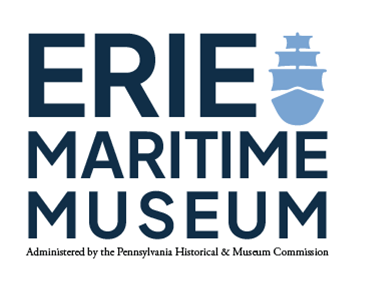Making History?
Blog Written by Hannah Gullifer, Erie Maritime Museum Intern
Within the collections of the Erie Maritime Museum are several images known as ‘carte-de-visite’. As a learning intern, I had no clue what that meant. I could deduce that it was a card given on a visit… come to find out that’s not a far-off definition at all. The Science and Media Museum defines it as “a photograph mounted on a piece of card the size of a formal visiting card”. Also commonly known as a CDV, or calling card, they were used to display one’s wealth. These are not to be mistaken for other similar mainstream small image forms like daguerreotypes or ambrotypes. Daguerreotypes are photographs on a silvered copper plate, born from the first successful form of commercial photography. Ambrotypes, also known as collodion positives, are images on glass. They were sturdier and harder to break than the thin copper of daguerreotypes and became more popular. However, the carte-de-visit cards were favored much more than others as they were small - roughly 3 x 2 inches - harder to damage, and easy to hand out.
The trend began with a French photographer named Andre Adolphe Eugene Disdéri in 1854. He saw that these small images were popular and found a way to make them cost-effective as well. Desdéri began to take several pictures on one photo plate using a special camera with four lenses. This made each picture unique, and customers would have several pictures to give when they visited others. The carte-de-visit cards truly became popular in England in 1857 when images of royals like Queen Victoria, Prince Albert, and others were taken in the format. People began to collect cards in albums specially made for the small pictures, eyes peeled for celebrity cards that could be purchased. Like the 19th century version of trading cards, people could accumulate images of family members and friends, and make a stop at a stationary shop for one of Adelina Patti or the Queen.
The cards in the Erie Maritime Museum collection are those of William Henton, Stephen Champlin, Napoleon Collins – each of whom were sailors aboard the USS MICHIGAN, also pictured on a card. The CDV of MICHIGAN represents one of the earliest snapshots of the vessel. This image of the Navy’s first iron steamer was taken in the 1860s by a photographer named Benedict in her home of Lake Erie. She is seen floating proudly, majestically, where she was raised and served her career until being scrapped in 1949.
USS MICHIGAN Carte-de-viste
This image is one of the earliest made of the U.S.S. MICHIGAN, the U.S. Navy's first iron steamer. While the vessel made Erie, Pennsylvania her home port throughout her entire career, she is shown here at anchor at Put-in-Bay, Ohio, in the mid-to-late 1860s.
FN2016.11.6
William Henton CDV
William Henton’s carte-de-visit was taken in New York City in the mid-1800s. R. A. Lewis photographed Henton along with many others as a photographer and printer/publisher. Henton served on board the USS MICHIGAN as a Crewman in 1847, on and off as a Civilian Pilot from 1853-1876, and as a Boatswain 1875-76. A boatswain is the person in charge of a ship’s hull maintenance and related work. Also known as ‘boats’, the position is one of the oldest jobs in all of the sea services. The word originates from the Ango-Saxon word ‘batswegen’ or ‘boats servant’, as well as the Old Norse word ‘sveinn’ meaning apprentice.
FN2016.11
Stephen Champlain CDV
Stephen Champlin’s image was also captured in New York City, by the well-known photography company Charles D. Fredricks & Co. Champlin was an officer under Oliver Hazard Perry and led the SCORPION in the Battle of Lake Erie, in which he is said to have fired the first and last shot. He was the 2nd Commander of the USS MICHIGAN from November 4, 1845 to March 31, 1848. He oversaw 15 rescue operations and several more criminal patrols of the Great Lakes. The picture was taken in the 1860s, after his retirement. Champlin passed in 1870 as the last surviving officer of the Battle of Lake Erie.
FN2016.11.3
Napoleon Collins CDV
Napoleon Collins was photographed by Matthew Brady’s Studio and published by E. & H. T. Anthony & Co. in the 1860s. He served over 40 years in the Navy where he commanded the Union Navy’s Steam Sloop WACHUSETT and captured the Confederate Sloop-of-War FLORIDA. He towed the sloop to hand deliver it to US authorities in Virginia. Collins served as a junior officer aboard the MICHIGAN, then as a Lieutenant in 1850-53 and 1858-60, and was promoted to Commander in 1862. In 1866 he earned the promotion to Captain. In the 1870s, Collins returned to Lake Erie as a Navy Commodore to work as a Light-House Inspector in the 10th US Light-House District. He was then promoted to Rear-Admiral in charge of the South Pacific Squadron. Collins passed in 1875.
FN2016.11.4
These images in the Erie Maritime Museum collection caught my eye because they had a fun name, but in looking deeper there was an entire culture behind it. There was a wave of people photographing family members, friends, and celebrities for fun and to build collections. Did they know they were documenting history? That they would be in museums one day? Each one of these little cards has an entire story behind them that can help us connect to a time we can always learn more about.
C. Harding, How To Spot a Carte de Visite, 2013, How to spot a carte de visite (late 1850s–c.1910) - National Science and Media Museum blog





